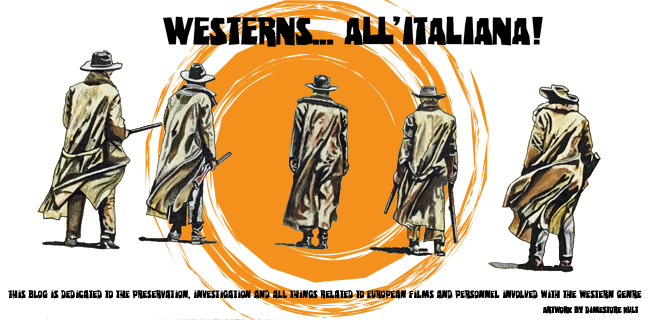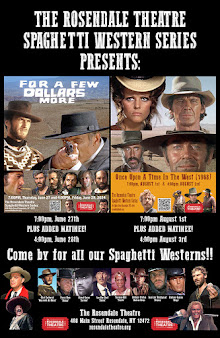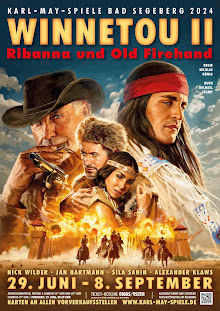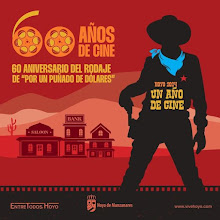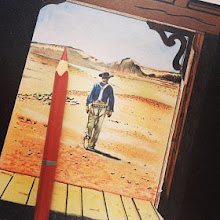New York Times Film
Review
By Vincent Canby
May 29, 2019
ONCE upon the time in
Italy, there lived a little boy named Sergio Leone who, like all little boys,
went to the movies quite a lot, particularly to see Hollywood Westerns. In
Italy, people like John Wayne and Gary Cooper spoke Italian slang, which never quite
corresponded to their lip movements. As a result, there was always something of
a distance between the sound and the image of the movies that enchanted
Sergio.When he grew up, Sergio became a movie director. Because Hollywood had
more or less abandoned the Western, he went to Spain where he made his own
Westerns with a star cast off from American television. "A Fistful of
Dollars." "For a Few Dollars More" and "The Good, the Bad
and the Ugly" made Leone a fortune, Clint Eastwood a first-class movie
star, and created what was, in effect, a new movie genre. The world of a Leone
Western is just as enchanted as it was in the films the director saw as a
child, but the values have become confused. Heroes as well as villains are apt
to be motivated by greed and revenge, and the environments in which they
operate are desolate and godless, though very beautiful. The Leone Westerns are
twice removed from reality, being based on myths that were originally conceived
in Hollywood studios in the nineteen-thirties. And, because Leone films are
usually shot in Italian and later dubbed into English, there is that same
distance between sound and image that existed in the John Wayne movies that
Leone watched in his youth. One result of this is that the Leone Western may seem
even more arbitrarily violent and brutal than it really is. "Once Upon the
Time in the West," which opened yesterday at Loew's State 2 and at Loew's
Orpheum, is the biggest, longest, most expensive Leone Western to date, and, in
many ways, the most absurd. It is also the first Leone movie to be shot on
American locations (Arizona and Utah), although most of it apparently was
photographed in Leone's beloved Spain. Granting the fact that it is quite bad,
"Once Upon the Time in the West" is almost always interesting,
wobbling, as it does, between being an epic lampoon and a serious hommage to
the men who created the dreams of Leone's childhood. The movie is eclectic in
dramatic detail—it contains the plots of at least a half-dozen movies you've
already seen—as well as in origin. Among those who are credited with the story
and screenplay are Leone himself and Bernardo Bertolucci, one of the most
original of the new crop of Italian moviemakers ("Before The
Revolution," "Partner"). Credited with having contributed to the
English dialogue is none other than Mickey Knox, best known here as a member of
Norman Mailer's rat pack. The movie's narrative outline, which has to do with
efforts to grab some land important to the building of a railroad to the West,
is simply an elaborate excuse for a series of classic confrontations between
classic Western types. Those include Henry Fonda, the kind of killer who will
shoot a child at point-blank range; Claudia Cardinale, the hooker from New
Orleans (which explains her accent, as it often did when Marlene Dietrich
turned up on the frontier); Jason Robards, a gunman with a fondness for widows
who look like Miss Cardinale, and Charles Bronson, who plays Leone's favorite
Western character, the enigmatic Man With No Name, en route from nowhere to
nowhere, a kind of Flying Dutchman of the plains. Although "Once Upon the
Time in the West" has moments of genuine impact, such as an early
shoot-out between Bronson and three hired killers at a lonely way station, it
is mostly fun for the way it cherishes movie styles and attitudes from the
past.It's no accident that people like Lionel Stander, Jack Elam and Keenan
Wynn turn up in supporting roles, or that when Miss Cardinale, newly arrived in
the West, takes the carriage to her husband's farm, the route takes her through
John Ford's Monument Valley. I also like the kind of pure movie exchange that
takes place when Henry Fonda confronts one of his men for having betrayed a
confidence. "You can trust me," says the man. Replies Fonda: "How
can I trust a man who wears both a belt and suspenders? He don't even trust his
own pants." "Once Upon the Time in the West" thus is a movie
either for the undiscriminating patron or for the buff. If you fall somewhere
in between those categories, you had better stay home or go see "If It's
Tuesday, This Must Be Belgium."
